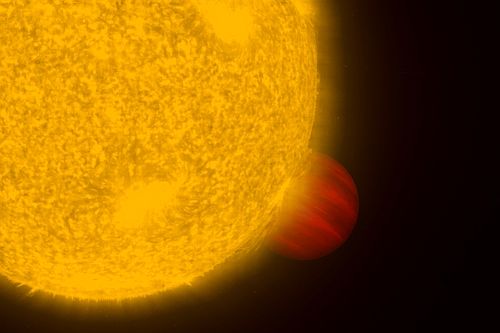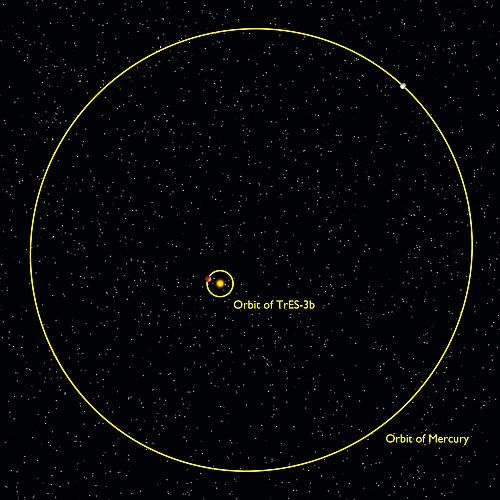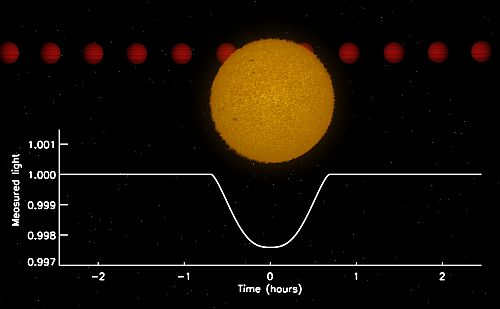Two teams of astronomers have measured light emitted from extrasolar planets around sun-like stars for the first time ever using ground-based telescopes. These results were obtained simultaneously and independently by the two teams for two different planets.
These landmark observations open new possibilities for studying exoplanets and their atmospheres.
One of the teams, from the University of Leiden, used the William Herschel Telescope (WHT) and the United Kingdom Infrared Telescope (UKIRT) on Mauna Kea in Hawai`i. The observed planet, named TrES-3b, is in a very tight
orbit around its host star, TrES-3, transiting the stellar disk once per 31 hours. For comparison, Mercury orbits the sun once every 88 days. TrES-3b is just a little larger than Jupiter, yet orbits around its parent star much closer than
Mercury does, making it a "hot jupiter."
UKIRT observations caught the transit, from which the size of the planet has been worked out extremely precisely. The WHT observations using LIRIS near-infrared imager and spectrograph, show the
moment the planet moves behind the star, and allow the strength of the planet light to be measured. Astronomers have been trying to observe this effect from the ground for many years, and this is the first success.
 |
TrES-3b is a gas giant like Jupiter, but with an orbit much closer to its star than Mercury is to our Sun. That puts it into the category of "hot jupiter" planets. This graphic illustrates the concept of a "hot jupiter". Credit: Leiden Observatory. [ JPEG ]
|
Ernst de Mooij, leader of the research team, emphasises, “while a few such observations have been conducted previously from space, they involved measurements at long wavelengths, where the contrast in brightness between
the planet and the star is much higher. These are not only the first ground-based observations of this kind, they are also the first to be conducted in the near-infrared, at wavelengths of 2 micron for this planet, where it emits most of its
radiation.”
Fellow researcher Dr Ignas Snellen adds, “we have been able to measure the temperature of TrES-3b to be a bit over 2000 Kelvin. Since we know how much energy it should receive by the type of its host star, this gives us
insights into the thermal structure of the planet's atmosphere, which is consistent with the prediction that this planet should have a so-called 'inversion layer.' It is absolutely amazing that we can now really probe the properties of such a distant world”.
 |
This image shows a comparison between the sizes of the orbits of TrES-3b and Mercury around the primary star. Note that while the orbits are to scale, the sizes of the planets and the star are not. Credit: Joint Astronomy Centre. [ JPEG ]
|
An atmospheric inversion layer is a layer of air where the normal change of temperature with altitude reverses. For example, while we are all familiar with the general decrease of the air temperature as we rise above the ground, often
there is a point (usually at a good few thousand feet) where the temperature starts to increase again. This inversion layer prevents air below the inversion layer from escaping to higher altitude.
Many places on Earth have strong inversion
layers, such as big cities with lots of pollution. La Palma has a tropical inversion layer at about 1800-1300 metres so it usually sits well below the summit. It is this inversion layer that isolates the upper atmosphere from the moist
maritime air at lower levels, ensuring that the summit skies are dry and clear, making La Palma such an excellent observing site. It is interesting that the world's great observatories are situated above inversion layers and are now being
used to study inversions in planetary atmospheres outside our own solar system.
Current theory says that there are two types of "hot jupiters," one with an inversion layer, and one without. The type is predicted to depend on the amount of light the planet receives from its star. If the inversion layer could be
confirmed, for example by measurements at other wavelengths, these observations would fit in perfectly with this theory.
 |
This image shows the star eclipsing the planet. As the planet disappears behind the star, the light coming from the whole system decreases because of the absence of the planet's light. This allows for precise measurements of the light emitted by the planet.
Credit: Joint Astronomy Centre. [ JPEG ]
|
Measuring the emitted light from a planet at different wavelengths reveals the planet's spectrum. This spectrum can be used to determine the planet's day-side temperature. In addition, this spectrum will depend on many physical
processes in the planet's atmosphere, such as absorption by molecules like water, carbon monoxide and methane, redistribution of heat around the planet, and temperature structure as a function of height (the aforementioned
inversion layer). It will be very useful to be able to compare these for different planets in different environments.
"The shorter infrared wavelength targeted in our work is where the planet emits most of its energy and where the
molecules have the most influence on the spectrum," says de Mooij.
Alongside the discovery of de Mooij and Snellen, a second team has made a ground-based detection of a different extrasolar planet, OGLE-TR-56b, at the wavelength of 1 micron. Both landmark observations will open
up a new window for studying exoplanets and their atmospheres using ground-based telescopes. They show great promise for using future extremely large telescopes which will have much higher sensitivity than the telescopes used today.
More information:
Science contacts:
- Dr Ignas Snellen
Leiden University
Email: snellen@strw.leidenuniv.nl
- Ernst de Mooij
Leiden University
Email: demooij@strw.leidenuniv.nl
References:
- E. J.W. De Mooij and I. A.G. Snellen, 2009, "Ground-based K-band detection of thermal emission from the exoplanet TrES-3b", A&A, 493, accepted for publication.
- D. K. Sing and M. López-Morales, 2009, "Ground-based secondary eclipse detection of the very-hot Jupiter OGLE-TR-56b", A&A, 493, accepted
for publication.



